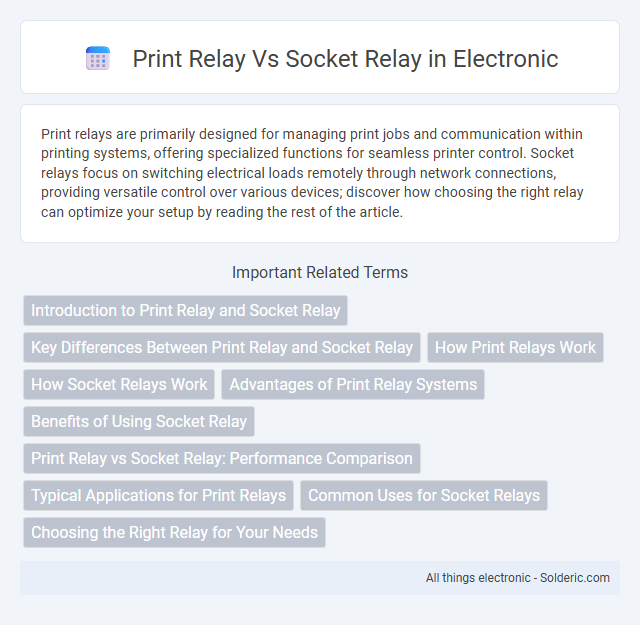Print relays are primarily designed for managing print jobs and communication within printing systems, offering specialized functions for seamless printer control. Socket relays focus on switching electrical loads remotely through network connections, providing versatile control over various devices; discover how choosing the right relay can optimize your setup by reading the rest of the article.
Comparison Table
| Feature | Print Relay | Socket Relay |
|---|---|---|
| Definition | Middleware that routes print jobs between applications and printers | Network communication component that manages socket connections for data relay |
| Primary Use | Printing management and job routing | Real-time data transfer over network sockets |
| Communication Protocol | Usually supports multiple print protocols (e.g., IPP, LPR) | TCP/UDP socket-based communication |
| Latency | Optimized for print job batching; moderate latency | Low latency; suitable for real-time data streaming |
| Use Case | Printing systems, print job management in enterprises | Networked applications requiring fast data relay (e.g., chat, gaming) |
| Data Format | Print job formats like PDF, PCL, PostScript | Raw byte streams or serialized data over sockets |
| Reliability | Ensures print job completion and error handling | Depends on socket implementation; may include retries and error checks |
Introduction to Print Relay and Socket Relay
Print Relay and Socket Relay are two types of communication protocols used in networked printing environments. Print Relay typically involves traditional TCP/IP printing methods, connecting devices over a network to forward print jobs efficiently. Socket Relay uses socket programming to establish direct, low-level connections between devices, offering more control over data transmission and real-time communication.
Key Differences Between Print Relay and Socket Relay
Print relay uses printers to transmit signals for printing tasks, offering direct compatibility with printing devices, while socket relay employs electrical sockets to control power flow and devices remotely. Socket relays provide more robust control for electrical appliances with higher voltage capabilities compared to the low-voltage signal communication of print relays. Print relays optimize print job management and signal transmission efficiency, whereas socket relays focus on power switching reliability and remote device operation.
How Print Relays Work
Print relays function by intercepting print jobs sent from a computer and forwarding them to a designated printer or print server, effectively managing print tasks within a network. They use network protocols such as TCP/IP to facilitate communication between devices, ensuring reliable data transfer and reducing print queue congestion. Unlike socket relays that handle raw socket connections for various data types, print relays are specifically optimized for processing and managing print-related information, enhancing efficiency in print job distribution.
How Socket Relays Work
Socket relays operate by connecting directly to a relay socket, enabling easy installation and replacement without rewiring. These devices receive an electrical signal from your control system and use an internal electromagnetic coil to open or close contacts, controlling high-power circuits remotely. Their design ensures efficient switching and longevity in industrial automation and electrical control applications.
Advantages of Print Relay Systems
Print relay systems offer enhanced reliability and faster communication by directly interfacing with printing devices without relying on network protocols, reducing latency and minimizing connection failures. These systems enable seamless integration with various printer models, ensuring consistent print quality and lower maintenance costs. Your printing workflow benefits from simplified setup and improved efficiency compared to socket relay alternatives, making print relays ideal for high-demand environments.
Benefits of Using Socket Relay
Socket relays offer enhanced remote control capabilities by enabling communication over Ethernet or Wi-Fi, facilitating centralized management in automation systems. They provide increased flexibility and scalability for industrial environments, allowing seamless integration with various network protocols and devices. Socket relays minimize wiring complexity and improve system diagnostics through real-time monitoring and status feedback.
Print Relay vs Socket Relay: Performance Comparison
Print relay typically handles data transmission with higher throughput due to its optimized buffered printing mechanism, making it suitable for large volume, continuous print jobs. Socket relay offers lower latency and more efficient real-time communication, ideal for applications requiring immediate feedback and lower network overhead. Performance comparison shows print relay excels in batch processing environments, while socket relay outperforms in interactive, time-sensitive systems.
Typical Applications for Print Relays
Print relays are commonly used in printer control systems, networked printing environments, and automation of print job processing, where managing multiple print tasks efficiently is critical. Their design supports seamless integration with print servers, enabling centralized control and monitoring of printing devices. These relays are ideal for office automation, large-scale printing facilities, and environments requiring reliable signal switching to manage printer power and communication lines.
Common Uses for Socket Relays
Socket relays are commonly used in industrial automation systems for controlling motors, lighting, and HVAC equipment due to their ease of installation and replacement. They are preferred in applications requiring secure electrical connections with quick maintenance, such as manufacturing lines and building management systems. Their modular design supports versatile configurations, making them ideal for both AC and DC control circuits.
Choosing the Right Relay for Your Needs
Print relays offer clear status indication through visible contacts and are ideal for applications requiring easy maintenance and diagnostics. Socket relays provide flexible installation and easy replacement without rewiring, making them suitable for complex control panels or systems with frequent relay changes. Selecting the right relay depends on factors such as installation complexity, space constraints, and the need for real-time monitoring or quick maintenance.
Print Relay vs Socket Relay Infographic

 solderic.com
solderic.com